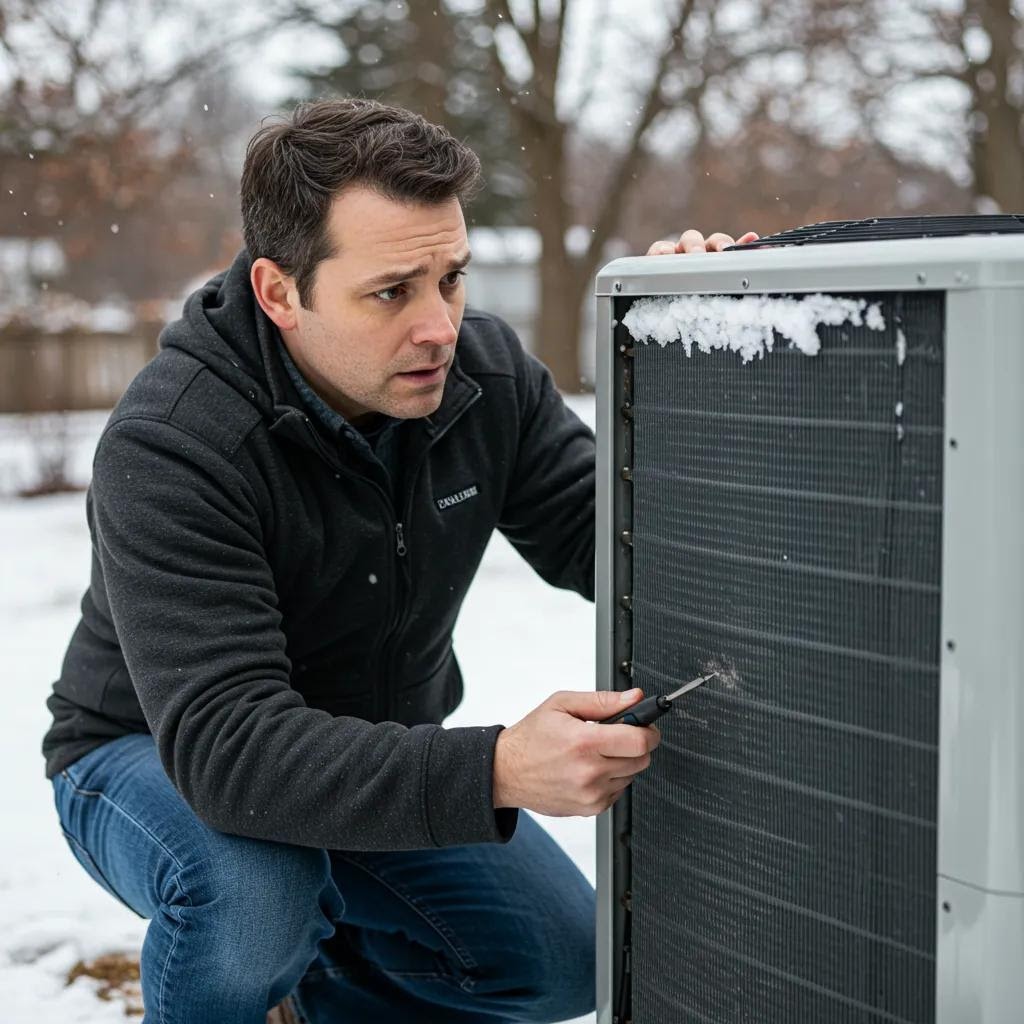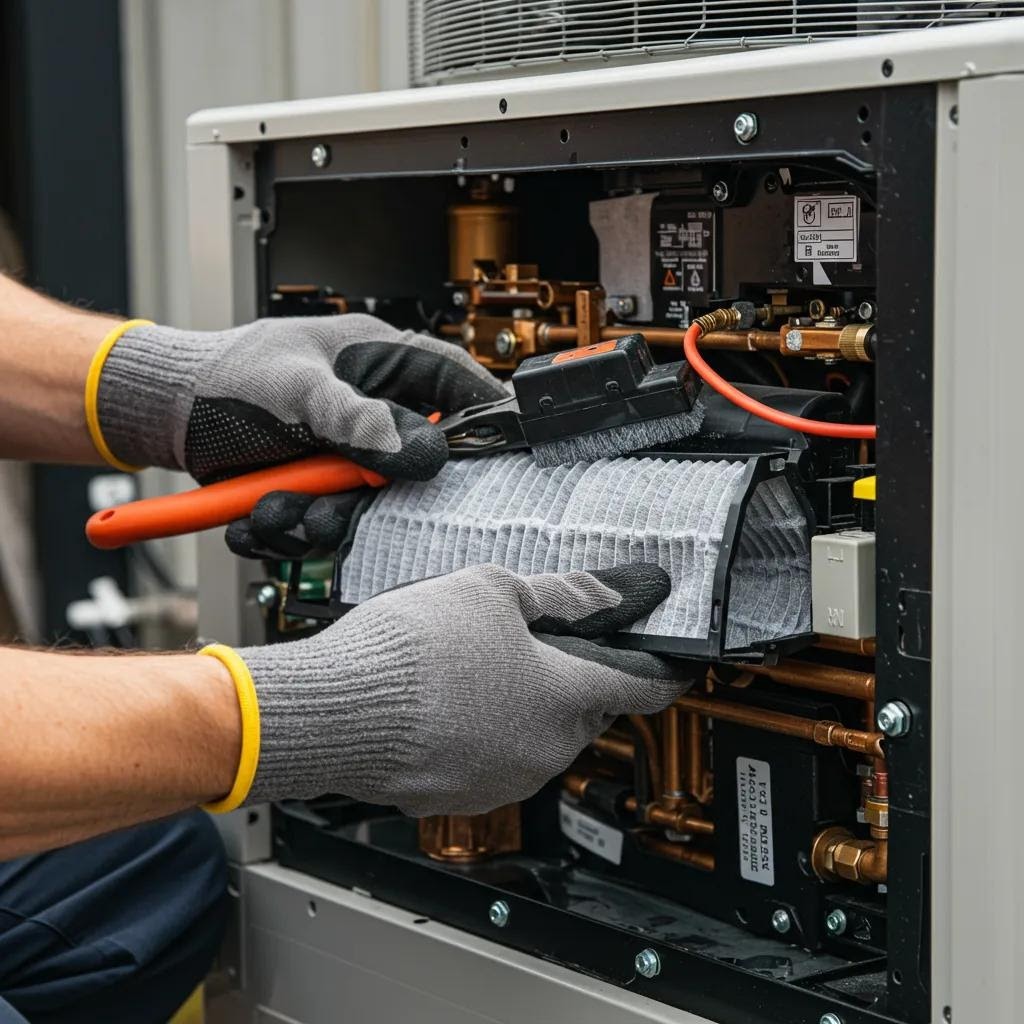Troubleshooting Heat Pump Issues
Troubleshooting Heat Pump Issues: Effective Solutions for Heating, Cooling, and Maintenance
A heat pump moves heat between your home and the outdoors to keep you comfortable year-round. When it acts up, figuring out the problem is key. This guide walks you through common heat pump hiccups—like when it’s not heating, not cooling, freezing over, making odd noises, or cycling too quickly. You’ll find simple checks you can do yourself and clear signs it’s time to call in the pros. We’ll cover how to spot issues, safe steps to take, and when to book a technician. Get ready for practical tips, charts to help you pinpoint problems, and maintenance schedules to keep things running smoothly. We’ll use terms like "heat pump troubleshooting," "heat pump not cooling," "heat pump not heating solutions," and "defrost cycle issues" to help you find what you need. Read on for straightforward advice that balances DIY fixes with expert repair guidance right here in North Carolina.
Why Is My Heat Pump Not Heating? Common Causes and Fixes
If your heat pump isn't heating, it’s usually because a key part—like the thermostat, airflow system, refrigerant, reversing valve, or electrical controls—isn't working right or is blocked. The heating process relies on refrigerant circulating and exchanging heat outside, so any interruption means less warm air for your home. You might notice cold air from your vents, ice on the outdoor unit, or the system running constantly or cycling on and off too fast. Each symptom points to a different potential issue and suggests a specific action. Knowing the likely causes helps you perform safe checks and know when to call for professional heat pump repair. Here are focused checks and actions to help you sort out heating failures quickly.
What Are the Symptoms of a Heat Pump Not Heating?

Cold air blowing when your thermostat is set to heat is the most obvious sign, often pointing to a control or component problem. If you notice reduced airflow from vents, the system running for extended periods, or visible ice on the outdoor unit, it suggests issues with heat exchange or airflow. Electrical problems, like tripped breakers or a blank thermostat display, usually mean a power or control issue, not a refrigerant problem. These checks help you determine if it’s a simple fix you can handle or if you need a professional to look at refrigerant, reversing valve, or compressor issues.
How Does a Frozen Outdoor Unit Affect Heating Performance?
Ice on the outdoor coil blocks airflow and stops heat transfer, meaning your system can’t pull heat from the outside air and will blow cold air inside. Normally, the defrost cycle melts this frost, but persistent ice indicates restricted airflow, low refrigerant, or a faulty defrost control. Running a frozen unit can strain the compressor and turn small problems into major repairs. For immediate safety, switch the system to off and let it thaw naturally. Avoid trying to chip away ice, as this can damage the coils.
How to Identify and Fix Low Refrigerant Levels in Your Heat Pump
Low refrigerant leads to poor heating, hissing sounds, and ice on the coils because the pressure drops too low. Handling refrigerant is regulated and requires specialized tools to detect leaks and certified technicians for repairs. Simply adding refrigerant without fixing the leak only masks the problem. Professional diagnostics involve pressure testing, leak detection, and heat pump service to the correct levels. If you hear hissing, see oily residue, or notice a rapid drop in performance after basic checks, schedule professional heat pump repair right away to prevent compressor damage.
What Role Does the Reversing Valve Play in Heating Failures?
The reversing valve is what allows your heat pump to switch between heating and cooling modes. If it fails or gets stuck, your system might blow cold air when it should be heating, or act erratically. Symptoms of a bad reversing valve include immediate mode switching, mixed-temperature air from vents, or partial mode changes. Diagnosing this involves checking if the valve is activating correctly and how the refrigerant is flowing, which usually requires a technician with specialized tools. Replacing or repairing the reversing valve is a job for an expert and typically part of a professional service call.
When Should You Call a Professional for Heat Pump Heating Issues?
Call a professional if you suspect electrical problems, refrigerant leaks, reversing valve failures, or compressor issues, or if your own safe checks don’t bring back the heat. If you smell burning electrical components, breakers keep tripping, or you have no heat in freezing weather, get immediate help. For complex problems, contact a qualified provider for heat pump repair to handle leak detection, electrical diagnostics, and component replacement. Fogg HVAC, Inc. offers expert heat pump repair services with trained technicians who can diagnose and safely fix refrigerant systems and reversing valve faults.
Different problems have different risks and require different solutions, so always prioritize safety and call a professional when you’re unsure.
Here’s a quick guide to help you match common heating symptoms with likely causes and recommended actions.
This table provides immediate steps to help you decide whether to perform safe checks or contact a professional.
What Causes Heat Pumps to Freeze Up and How Can You Fix It?
Heat pumps freeze up when the coil surface temperature drops below freezing, causing condensation to turn into ice and block airflow and heat transfer. This can happen due to restricted airflow from clogged filters, low refrigerant levels that lower coil temperature, or a faulty defrost cycle that fails to melt the ice. Persistent freezing reduces heating and cooling performance and can damage the compressor if the system runs while iced. Safe thawing methods and regular maintenance can restore function and prevent recurrence. If freeze-ups keep happening, it’s a sign you need professional diagnostics for potential refrigerant or defrost control issues.
What Are the Common Reasons for Heat Pump Freezing?
Typical causes include restricted airflow (from clogged filters or closed vents), low refrigerant from leaks, and blocked airflow around the outdoor unit due to debris or snow. Defrost cycle failures, often due to bad sensors or control boards, also lead to constant ice buildup. Seasonal weather and heavy pollen can make filters clog faster and coils get dirtier. Figuring out the exact cause starts with checking airflow and filters, then observing the ice patterns to guide your next steps.
How Do Dirty Air Filters and Low Refrigerant Lead to Freezing?
Dirty filters reduce the amount of conditioned air flowing over the indoor coil, making the coil colder and allowing frost to form as condensation freezes. Low refrigerant lowers the evaporating pressure, making the coil even colder during operation and causing similar freezing conditions. Both issues reduce heat transfer efficiency and can lead to complete ice coverage if not fixed. Regular filter maintenance and professional refrigerant checks prevent the conditions that cause freeze-ups.
How Does the Defrost Cycle Work and What Happens When It Fails?
The defrost cycle is designed to periodically reverse the refrigeration process or use electric heat to melt frost off the outdoor coil. It’s usually triggered by sensors or a timer. Key parts include defrost control boards and outdoor temperature or pressure sensors that start and stop the defrost process. If these controls fail, ice will keep building up, defrost cycles will be too short, and the compressor can be strained. When defrost components malfunction, a technician needs to test sensors, check control timing, and replace any faulty parts.
What Are Safe DIY Steps to Thaw a Frozen Heat Pump?
The safest way to thaw a frozen heat pump is to turn the thermostat off or set the system to "defrost" and let the unit warm up on its own. Never try to chip or pry ice off, as this can damage the coils. Remove any loose snow or obstructions around the outdoor unit to help it thaw naturally. After it’s thawed, monitor the system to see if it freezes up again. Once thawed, change the air filter and test normal operation. If it freezes up again, contact a professional for further diagnostics.
When to Contact Fogg HVAC for Heat Pump Freezing Problems
Contact professional service if your heat pump freezes up repeatedly even after changing the filter and clearing obstructions, or if the defrost cycle doesn’t work and ice returns quickly. Fogg HVAC, Inc. offers heat pump maintenance and diagnostic services that include checking defrost controls, detecting leaks, and inspecting refrigerant to fix the root causes. Their local service and emergency response can minimize downtime and prevent compressor damage. Scheduling professional maintenance helps catch problems early and reduces the chance of repeated freeze-ups.
The table below summarizes causes, how to detect them, and what to do for freeze-up situations.
Use this table to determine if a DIY fix is enough or if you need heat pump repair services.
Why Is My Heat Pump Making Strange Noises? Diagnosing and Fixing Unusual Sounds
Unusual noises from your heat pump often signal mechanical or refrigerant issues, such as loose panels, debris in the fan, failing bearings, refrigerant leaks, or compressor problems. Each type of noise can point to specific causes: hissing might mean pressure issues, rattling could be loose parts or foreign objects, and thumping might indicate motor or compressor imbalance. Safe troubleshooting involves visual checks with the power off, noting when the noises occur, and avoiding operation that could worsen mechanical damage. If noises suggest electrical arcing, burning smells, or severe mechanical failure, professional diagnosis and repair are necessary to ensure safety.
What Does a Hissing Noise Indicate About Your Heat Pump?
Hissing can indicate a refrigerant leak, a pressure equalization sound during valve operation, or air whistling through tight spots. To tell the difference, look for oily residue, reduced performance, or listen closely to the refrigerant lines. If you suspect a refrigerant leak, it requires immediate professional leak detection rather than a DIY fix due to safety and environmental regulations. If hissing is accompanied by reduced performance, schedule heat pump repair to find and fix the leak.
How to Identify Rattling or Banging Sounds and Their Causes
Rattling or banging usually comes from loose panels, debris in the outdoor fan, or failing fan motor mounts. Sometimes, ductwork or mounting hardware can transmit vibrations. Safe checks include turning off the power, inspecting the outdoor cabinet for foreign objects, and tightening accessible panels. If the source is an internal motor failure or compressor mounting issue, further operation could cause damage and warrants professional service. Document the noise patterns and call a technician if simple fixes don’t stop the sound.
What Does a Thumping Noise Mean for Your Heat Pump Motor?
Thumping often signals an imbalanced fan blade, worn-out bearings, or early compressor mechanical trouble—it’s a more serious mechanical indicator. Continuing to run the unit with a thumping sound risks bearing failure or compressor seizure, which are expensive to fix. Immediate steps include shutting down the unit and calling a technician to inspect bearings, fan balance, and compressor health. Professional diagnosis of the motor or compressor is needed to prevent further damage.
How Can You Safely Troubleshoot Heat Pump Noises at Home?
Start with a safety-first approach: turn off the power at the breaker, visually inspect the outdoor unit and ductwork, and note when the noises happen during the system’s cycles. Record videos or audio of recurring noises and log the timing (start-up, steady operation, shutdown) to help technicians diagnose intermittent issues. Avoid running equipment that emits burning smells or severe mechanical noises until it’s inspected. These steps reduce risk and speed up professional diagnosis.
When Should You Schedule Professional Noise Diagnosis and Repair?
Schedule professional inspection when noises continue after visual checks, if you notice electrical smells or arcing, or if mechanical banging and thumping persist. Ongoing or worsening sounds indicate underlying component failure that could lead to a complete system breakdown if not addressed promptly. Fogg HVAC, Inc. offers diagnostic services that prioritize safety and aim to quickly identify problematic components, recommending repair or replacement. Early professional intervention often prevents larger repairs and restores safe operation.
Here’s a short list of common noises and their most likely causes to help you prioritize.
- Hissing: Could be a refrigerant leak or pressure equalization — check for oily residue and call a technician if suspected.
- Rattling/Banging: Loose panels or debris — turn off power and inspect, tighten panels if safe.
- Thumping: Motor imbalance or compressor issue — turn off power and schedule professional inspection.
Documenting the noise characteristics helps technicians pinpoint faults more efficiently.
How to Diagnose and Resolve Heat Pump Short Cycling Issues
Short cycling is when your heat pump turns on and off frequently in short bursts, which lowers efficiency, increases wear and tear, and drives up utility bills. Causes can include an oversized system, thermostat placement or calibration problems, clogged airflow, or control issues that misread temperatures. Diagnosing short cycling involves checking thermostat settings, verifying proper airflow, and logging cycle times to spot patterns. Solutions range from fixing the filter and thermostat to professional system sizing reviews and control adjustments.
What Is Heat Pump Short Cycling and Why Does It Happen?
Short cycling occurs when the system reaches its set temperature or trips a safety limit too quickly and shuts off before completing a full, efficient run, leading to frequent restarts. This behavior puts extra stress on the equipment, reduces dehumidification, and can shorten component life. Common triggers include oversized units that overshoot the target temperature, thermostats placed incorrectly where they sense local temperatures instead of the room average, or airflow restrictions causing rapid temperature swings. Identifying the trigger requires targeted checks and cycle logging.
How Does an Oversized Heat Pump Cause Short Cycling?
An oversized heat pump delivers more heating or cooling than your space needs, reaching the thermostat setpoint very quickly and shutting off. This prevents proper humidity control and leads to frequent on/off cycles. The mismatch between the system's capacity and the home’s load affects comfort and system longevity, often requiring a professional load calculation. Solutions might include installing better controls, staging capabilities, or, in extreme cases, replacing the system with a correctly sized unit. A professional assessment will determine if control changes or system replacement is the best course of action.
How Can Clogged Airflow Lead to Short Cycling?
Clogged filters and restricted ducts reduce the amount of conditioned air being delivered, causing uneven temperature readings and premature cycling as thermostats detect brief, localized temperature changes. Restoring airflow by replacing filters and checking vents often stabilizes cycle times and improves comfort. If short cycling continues after fixing airflow issues, it suggests deeper control or sizing problems that require a technician’s evaluation. Keep your filters clean and ducts clear to reduce the chance of airflow-related short cycling.
What Are the Steps to Troubleshoot Short Cycling Safely?
A safe troubleshooting sequence begins with checking the thermostat mode and batteries, replacing the air filter, and ensuring all vents are open and unobstructed. Next, document the on/off cycle times and indoor temperature changes over several hours to identify patterns. If short cycles persist, note any error codes or breaker trips and contact a professional for control and compressor diagnostics. Gathering this data helps speed up professional diagnosis and pinpoint whether controls, system sizing, or electrical faults are the cause.
When to Seek Expert Heat Pump Repair for Short Cycling
Seek professional repair when short cycling continues after basic checks, if electrical components show faults, or if you observe the compressor cycling rapidly. These indicate higher-risk mechanical or control failures. Typical professional fixes include thermostat replacement or recalibration, control board adjustments, and sometimes, an evaluation of the system’s sizing. Timely professional assessment prevents progressive component wear and restores efficient operation.
Use this numbered checklist to prioritize short-cycling diagnostics before calling a technician.
- Verify thermostat settings, mode, and battery condition.
- Replace the air filter and ensure all vents are open.
- Log on/off cycle times and temperature changes over 24 hours.
- If cycling persists, capture any error codes and call a professional for diagnostics.
Collecting accurate cycle data helps technicians diagnose efficiently.
What Are Essential Heat Pump Maintenance Tips to Prevent Issues?

Regular maintenance keeps your heat pump running efficiently and prevents many common problems by ensuring clean airflow, proper refrigerant levels, and reliable controls. The core idea of preventive maintenance is simple: clean coils and filters maintain heat transfer, electrical inspections catch failing components early, and scheduled tune-ups identify emerging refrigerant or defrost issues. Following a routine maintenance plan reduces emergency repairs, improves comfort, and extends the life of your equipment. Here are recommended tasks, how often to do them, and the benefits that show why maintenance plans are a smart investment.
How Often Should You Schedule Professional Heat Pump Check-Ups?
Annual professional tune-ups are generally recommended. For systems that get heavy use or homes with specific comfort needs, biannual checks are advised, ideally before the peak winter or summer seasons. Seasonal inspections align servicing with the demands of pre-winter heating and pre-summer cooling in North Carolina’s climate. Professional checks include system performance testing, refrigerant verification, electrical safety inspections, and defrost control validation. Regular scheduling catches small problems early, reducing the chance of emergency repairs.
How to Clean and Replace Your Heat Pump Air Filter Yourself
Find the return air grille or the access panel for your indoor unit. Turn off the system power, then remove the filter for inspection. Disposable filters should be replaced, while washable filters need to be cleaned and completely dried before putting them back. Follow the manufacturer’s instructions for the correct filter type and MERV rating to balance airflow and indoor air quality. You’ll typically need to replace filters every 1–3 months, depending on how many people and pets are in the home. Keeping filters clean restores airflow and often resolves many performance issues.
What Are the Benefits of Regular Heat Pump Maintenance Plans?
Maintenance plans offer predictable service, priority scheduling, and fewer emergency repairs, leading to greater system reliability and peace of mind. Plans often include scheduled inspections, cleaning, performance checks, and discounted repair rates, all of which lower the total cost of ownership. Consistent maintenance improves energy efficiency, saving you money on utility bills and extending component life. Signing up for a maintenance plan reduces downtime and helps catch issues before they require costly replacements.
How Does Proper Maintenance Improve Heat Pump Efficiency and Longevity?
Maintenance preserves heat exchange efficiency by keeping coils and filters clean, and it prevents premature electrical and mechanical failures through routine inspections and tightening. Correct refrigerant levels and timely control calibration ensure optimal compressor operation and reduce strain. Regularly serviced systems maintain their designed performance, lowering energy consumption and extending their service life. These positive outcomes demonstrate why preventive maintenance is both energy-smart and cost-effective.
When Should You Call Fogg HVAC for Heat Pump Repair and Emergency Service?
Call Fogg HVAC, Inc. for repairs when you encounter electrical arcing, major refrigerant leaks, persistent compressor noise, or a complete system failure that impacts safety or habitability. They offer 24/7 emergency service and local coverage for Cary, Raleigh, and Apex to respond to urgent situations requiring immediate technical expertise. Their experience and diagnostic capabilities help prioritize safety and restore reliable heating or cooling with appropriate repairs or heating services or installation recommendations. Below are clear guidelines for emergency versus scheduled service and steps to prepare for a technician's visit.
Which North Carolina Areas Does Fogg HVAC Serve for Heat Pump Services?
Fogg HVAC, Inc. serves Cary, Raleigh, and Apex in North Carolina, offering local scheduling and emergency response throughout these areas. Localized service means technicians can arrive with the right parts and knowledge of common regional issues, reducing repeat visits and repair time. Homeowners in these cities can expect diagnostics and repair recommendations specific to their area, considering local climate impacts. Knowing the service area helps homeowners choose the right provider for quick response.
How to Schedule Your Heat Pump Repair or Installation Appointment Today
When booking, have your system’s make and model ready if known, list the symptoms you’ve observed and any checks you’ve already performed, and indicate the urgency level to help prioritize the visit. You can schedule by calling the provided business phone number and requesting service; providing clear symptom information speeds up the triage process. During the visit, technicians will perform on-site diagnostics, provide a clear outline of required repairs or installation options, and explain the next steps. Being prepared helps the technician deliver faster, more accurate service.
The checklist below summarizes how to prepare for a repair or installation appointment.
- Document system symptoms, how it behaves during operation, and any error codes.
- Note any recent maintenance actions (like filter changes or power resets).
- Provide the system make/model if available and state your location within Cary, Raleigh, or Apex.
- Call the service phone number to schedule and indicate if it’s an emergency.
Arranging service with prepared information helps technicians diagnose efficiently and restore safe, effective heat pump operation.
Conclusion
Knowing how to troubleshoot heat pump issues empowers you to maintain comfort and efficiency at home. By identifying symptoms and understanding when to call for professional help, you can prevent minor problems from becoming expensive repairs. Regular maintenance and timely interventions ensure your heat pump operates at its best all year long. For expert assistance and customized maintenance plans, reach out to Fogg HVAC today.







.png)
.png)
.png)
.png)
.png)
.png)
.png)
.png)
.png)
